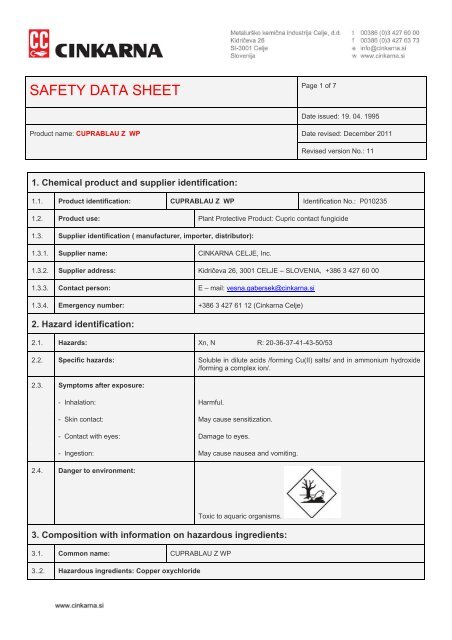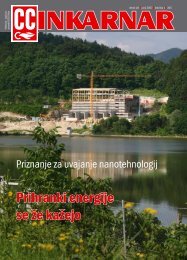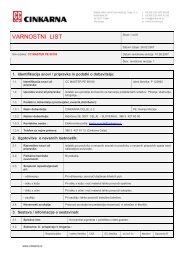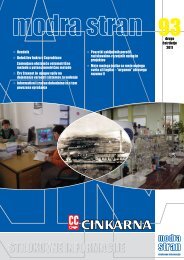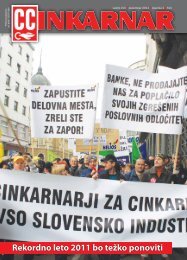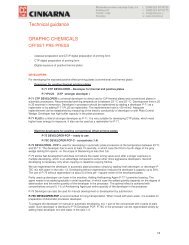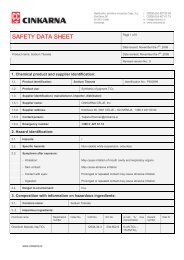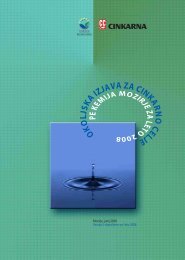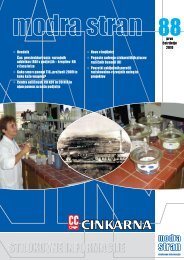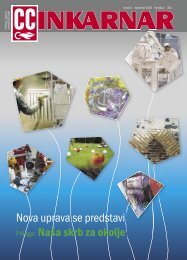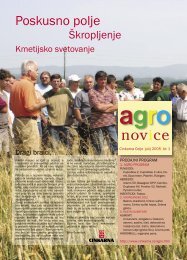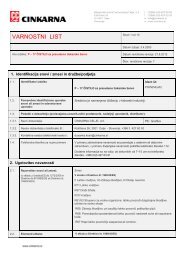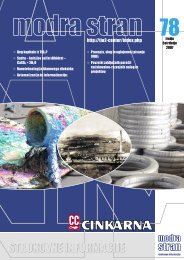Create successful ePaper yourself
Turn your PDF publications into a flip-book with our unique Google optimized e-Paper software.
<strong>SAFETY</strong> <strong>DATA</strong> <strong>SHEET</strong><br />
Page 1 of 7<br />
Date issued: 19. 04. 1995<br />
Product name: CUPRABLAU Z WP Date revised: December 2011<br />
1. Chemical product and supplier identification:<br />
Revised version No.: 11<br />
1.1. Product identification: CUPRABLAU Z WP Identification No.: P010235<br />
1.2. Product use: Plant Protective Product: Cupric contact fungicide<br />
1.3. Supplier identification ( manufacturer, importer, distributor):<br />
1.3.1. Supplier name: CINKARNA CELJE, Inc.<br />
1.3.2. Supplier address: Kidričeva 26, 3001 CELJE – SLOVENIA, +386 3 427 60 00<br />
1.3.3. Contact person: E – mail: vesna.gabersek@cinkarna.si<br />
1.3.4. Emergency number: +386 3 427 61 12 (<strong>Cinkarna</strong> <strong>Celje</strong>)<br />
2. Hazard identification:<br />
2.1. Hazards: Xn, N R: 20-36-37-41-43-50/53<br />
2.2. Specific hazards: Soluble in dilute acids /forming Cu(II) salts/ and in ammonium hydroxide<br />
/forming a complex ion/.<br />
2.3. Symptoms after exposure:<br />
- Inhalation: Harmful.<br />
- Skin contact: May cause sensitization.<br />
- Contact with eyes: Damage to eyes.<br />
- Ingestion: May cause nausea and vomiting.<br />
2.4. Danger to environment:<br />
Toxic to aquaric organisms.<br />
3. Composition with information on hazardous ingredients:<br />
3.1. Common name: CUPRABLAU Z WP<br />
3..2. Hazardous ingredients: Copper oxychloride
<strong>Cinkarna</strong> <strong>Celje</strong>, <strong>SAFETY</strong> <strong>DATA</strong> <strong>SHEET</strong> Page 2 of 7<br />
Product name: CUPRABLAU Z WP<br />
Chemical name Registration<br />
number<br />
Dicooper chloride trihydroxide<br />
CuCl2 · Cu(OH)2<br />
4. First aid measures:<br />
Index<br />
No.<br />
CAS No. EC No. wt./vol/%/max<br />
concentration<br />
Hazard<br />
symbol<br />
Risk Phrases<br />
1332-65-6 215-572-9 61.5 wt.% Xn, N 20-36-37-41-43-<br />
50/53<br />
4.1. General instructions: The product is harmful by inhalation. Ingestion in large quantities may<br />
cause gastroenteritis, nausea, vomiting and diarrhea. Systemic effects<br />
may follow and may include dizziness, elevated blood pressure, tremors.<br />
4.2. Inhalation: Remove victim to fresh air. If not breathing, give artificial respiration,<br />
preferably mouth-to-mouth. Get medical attention.<br />
4.3. Contact with skin: Remove contaminated clothing and shoes. Thoroughly wash the affected<br />
parts of the body with water and soap.<br />
4.4. Contact with eyes: Rinse the opened eye for 15 minutes under running water. If irritation and<br />
redness persist then seek medical help.<br />
4.5. Ingestion: Wash out mouth with water and give water to drink. Do not induce<br />
vomiting. Seek medical attention.<br />
4.6. First aid at work: Establish and maintain the necessary vital functions. If necessary,<br />
decontaminate the skin and mucous membranes. Use of adsorbens<br />
(activated carbon) is not applicable.<br />
5. Fire-fighting measures:<br />
Antidotes for heavy metal poisoning like dimerkaprol, Na2Ca-EDTA,<br />
penicillamine with ignorant substance are not indicated.<br />
5.1. Suitable extinguishing medium: Use dry chemical, carbon dioxide, water spray, or foam.<br />
5.1.1. Extinguishing media which shall not be<br />
used for safety reasons:<br />
Do not use direct water jet.<br />
5.2. Special exposure hazards: In the case of fire - hydrgen chloride and oxides of copper may form.<br />
Never rinse the contaminated soil with water. Water from the fire should<br />
not be allowed to enter drain systems or watercourses. It should be<br />
separately collected and disposed of at an appropriately regulated<br />
landfill, in accordance with the applicable rules of the disposal of<br />
hazardous waste.<br />
5.3. Special protective fire fighting<br />
equipment, indicated by standard if any:<br />
6. Accidental release measures:<br />
n.a.<br />
6.1. Personal safety measures: Fungicide applicators & workers must refer to the Product Label and<br />
Directions For Use attached to the product for Agricultural Use<br />
Requirements in accordance with the EPA Worker Protection.<br />
6.2. Environment protection: This fungicide is toxic to fish and aquatic organisms. Do not allow rinsate<br />
from cleaning of equipment or disposed material to enter surface or<br />
ground water. Do not contaminate water by disposal of equipment<br />
washwaters.
<strong>Cinkarna</strong> <strong>Celje</strong>, <strong>SAFETY</strong> <strong>DATA</strong> <strong>SHEET</strong> Page 3 of 7<br />
Product name: CUPRABLAU Z WP<br />
6.3. Cleaning after accidental discharge: Use proper personal protective equipment as indicated in Section 8.<br />
Land Spill: Sweep up and place in suitable containers for later disposal.<br />
Avoid infiltration into surface and ground water.<br />
7. Handling and storage:<br />
7.1. Handling:<br />
Methods for cleaning up: Flush remainder with water (Absorb the<br />
remainder with sand, earth , vermiculite).<br />
Water Spill: If feasible, copper may be precipitated/ultrafiltrated with<br />
caustics or other chemicals and resulting sludge disposed of in a<br />
chemical landfill. According to local regulations.<br />
Environmental hazards: This fungicide is toxic to fish and aquatic<br />
organisms. Do not allow rinsate from cleaning of equipment or disposed<br />
material to enter surface or ground water. Do not contaminate water by<br />
disposal of equipment washwaters.<br />
7.1.1. Safety measures: Do not breathe dust, vapour, mist. Use only in a well-ventilated area.<br />
Minimize dust generation and accumulation.<br />
7.1.2. Technical measures: Store protected from moisture.<br />
7.1.3. Recommended and forbidden measures: Avoid ingestion and inhalation. Wash contaminated clothing and other<br />
protective equipment before storing or re-using.<br />
7.2. Storage:<br />
7.2.1. Conditions for safe storage: Store product in close original container in a dry, well-ventilated area<br />
away from incompatible substances. Store protected from moisture.<br />
7.2.2. Separating incompatible products: Keep away food, feed and drinking water.<br />
7.2.3. Special packaging: /<br />
7.2.4. Protection against static electricity: n.a.<br />
7.3. Specific use: Cuprablau Z is a preventive, contact fungicide used for controlling<br />
grapevine, potato, tomato, olive, onion and hop disease; apple, pear,<br />
peach and drupe disease.<br />
8. Exposure control/personal protection:<br />
8.1. Exposure limit values: n.a.<br />
8.2. Exposure control: Ventilation (locally and spatially).<br />
8.2.1. Health and safety measures at<br />
the workplace:<br />
Personal protection:<br />
Respiratory system protection: In enclosed spaces where the TLV may be exceeded, wear NIOSH approved dust<br />
or mist respirator.<br />
Skin and body protection: Coveralls over short-sleeved shirt and long pants; shoes plus socks.<br />
Hand protection: Chemical-resistant gloves made of any waterproof material.
<strong>Cinkarna</strong> <strong>Celje</strong>, <strong>SAFETY</strong> <strong>DATA</strong> <strong>SHEET</strong> Page 4 of 7<br />
Product name: CUPRABLAU Z WP<br />
Eye protection: Protective eyewear.<br />
General work hygiene: Wash contaminated clothing and other protective equipment before storing or reusing.<br />
8.2.2. Environment exposure control: n.a.<br />
9. Physical and chemical properties:<br />
9.1. General information:<br />
- appearance Wettable powder (WP), green-blue colour.<br />
- odour Odourless.<br />
9.2. Important health, safety and<br />
ecological information:<br />
- pH: 7,3 to 7,8 (1% water suspension, 20 o C).<br />
- Boiling point: No boiling point before decomposition.<br />
- Melting point: Decomposes on heating above 200 o C<br />
- Flash point: n.a. (solid)<br />
- Ignition point ( for solids and gases): n.a.<br />
-Explosive properties (upper/lower<br />
border):<br />
- Oxidation properties: n.a.<br />
No explosive properties.<br />
- Vapour pressure: n.a. (fine powder)<br />
- Relative density: n.a.<br />
- Solubility ( in water and fats): Water: < 10 μg/l Cu.<br />
Decomposition temperature of copper oxychloride is high, indicating a high<br />
energy of activation. It is, therefore considered inert under conditions of<br />
oxidation.<br />
- Partition coefficient: n-octanol/water Not viable due to the negligible solubility in water and n-octanol.<br />
- Other data: Self-ignition temperature: Not observed following use of many years.<br />
- Note: /<br />
10. Stability and reactivity:<br />
Wholly inorganic salts are not combustible or flammable.<br />
10.1. Stability and reactivity: The product is stable under normal conditions and in neutral media.<br />
10.1.1. Conditions to avoid: Moisture (substance is hygroscopic), substances with acid reaction.<br />
10.1.2. Incompatibility with other Materials with acid reaction, strong acids and bases, chlorates.
<strong>Cinkarna</strong> <strong>Celje</strong>, <strong>SAFETY</strong> <strong>DATA</strong> <strong>SHEET</strong> Page 5 of 7<br />
Product name: CUPRABLAU Z WP<br />
substances:<br />
10.2. Hazardous products of<br />
decomposition:<br />
10.3. Other data: /<br />
11. Toxicological information:<br />
11.1. Acute effects (acute toxicity,<br />
irritation and corrosivity):<br />
11.2. Chronic toxicity or repeated<br />
dose toxicity:<br />
This product is unlikely to spontaneous decompose.<br />
Acute oral LD50/Rat: > 2000 mg/kg<br />
Acute oral LD50/Mouse: 2235,5 mg/kg<br />
Dermal Irritation/Rabbit: Non irritating.<br />
Ocular Irritation/Rabbit: Non irritating.<br />
None known.<br />
11.3. Oversensibility: None known.<br />
11.4. Specific effects(CMR effects-<br />
carcinogenity,mutagenicity<br />
and toxicity for reproduction:<br />
12. Ecological information:<br />
None known.<br />
12.1. Ecotoxicity: Mobility-EC50/Daphnia magna Straus: 0,116 mg/l.<br />
Growth-EC50/Algae Scenedesmus subspicatus:<br />
0,62 mg/l (on surface); 10,03 (increase).<br />
Reproduction-EC50/Bacterium Pseudomonas putida Migula:<br />
0,574 mg/l (linear regression); 0,636 mg/l (interpolation).<br />
Acute Toxicity-LD50/Fish Brachydanio rerio Hamilton-Buchanan: 5,6 mg/l.<br />
Bee toxicity: Non toxic.<br />
12.2. Mobility: The degree of mobility of copper in the environment depends upon the pH of<br />
ambient soils and water. The higher the acidity, the more soluble copper salts are<br />
and, hence, the more mobile.<br />
12.3. Persistence and degradability: Long term degradation products may arise.<br />
At pH > 5 copper is practically immobilised. Copper mobilization increases with the<br />
acidity growth (strong effect already at pH < 4,5).<br />
12.4. Bioaccumulative potential: Bioaccumulation occurs only when copper is biologically abundant. Due to copper<br />
adsorption and compexity this abundance is greatly reduced depending on pH<br />
value and the presence of other cations. This is why copper rarely is a sign of<br />
toxicity.<br />
12.5. Results of PBT assessment: Cuprablau Z is not considered to PBT/vPvB.<br />
It is persistent, bioaccumulation is very low /fungicide is rarely an indicator of<br />
toxicity/.<br />
12.6. Other adverse effects: Do not contaminate streams, rivers or waterways.
<strong>Cinkarna</strong> <strong>Celje</strong>, <strong>SAFETY</strong> <strong>DATA</strong> <strong>SHEET</strong> Page 6 of 7<br />
Product name: CUPRABLAU Z WP<br />
13. Disposal considerations:<br />
13.1. Product: Product wastes are hazardous. Dispose in accordance with applicable Federal,<br />
State and Local laws and regulations.<br />
13.2. Contaminated packaging: Dispose in accordance with applicable Federal, State and Local laws and<br />
regulations.<br />
14. Transport information:<br />
14.1 ADR, RID:<br />
14.2. UN number: 3077<br />
Environmentally hazardous substance<br />
Class 9: Miscellaneous dangerous substances and articles.<br />
14.3. Name: Environmentally hazardous substance, solid,n.o.s. (61.5 wt.%: copper oxychloride)<br />
14.4. Class: 9<br />
14.5. Classification code: M7<br />
14.6. Packaging group: III<br />
14.7. Hazard label:<br />
14.8. Tunnel restriction code (TRC): ( E )<br />
15. Regulatory information:<br />
15.1. EC classification, letter, hazard labels, S and R (with the text), special regulations:<br />
15.1.1. Classification: Xn, N<br />
15.1.2. Labelling: R: 20-36-37-41-43-50/53 S: 2-13-39-45-60-61<br />
15.1.3. Risk Phrases: R 20 Harmful by inhalation.<br />
Xn N<br />
HARMFUL DANGEROUS FOR THE ENVIRONMENT<br />
R 36 Irritating to eyes.<br />
R 37 Irritating to respiratory system.
<strong>Cinkarna</strong> <strong>Celje</strong>, <strong>SAFETY</strong> <strong>DATA</strong> <strong>SHEET</strong> Page 7 of 7<br />
Product name: CUPRABLAU Z WP<br />
R 41 Risk of serious damage to eyes.<br />
R 43 May cause sensitization by skin contact.<br />
15.1.4. Safety Phrases: S 2 Keep out of the reach of children.<br />
15.1.5. Special provisions: /<br />
R 50/53 Very toxic to aquaric organisms, may cause long-term adverse effects in<br />
the aquatic environment.<br />
S 13 Keep away from food, drink and animal feeding stuffs.<br />
S 39 Wear eye/face protection.<br />
15.2. Regulations /Standards: EEC Directives.<br />
16. Other information:<br />
16.1. Write out the full text of any R<br />
phrases referred to under<br />
heading 2 and 3 of the SDS:<br />
S 45 In case of accident or if you feel unwell, seek medical advice immediately<br />
(show the label where possible).<br />
S 60 This material and its container must be disposed of as hazardous waste.<br />
S 61 Avoid release to the environment. Refer to special instructions(safety data<br />
sheets.<br />
20-36-37-41-43-50/53<br />
16.2. Staff training: Course from safety of health at work, fire safeties and treatments with hazardous<br />
chemicals.<br />
16.3. Recommended or restricted<br />
use of product:<br />
16.4. Instructions: Please read all labels carefully before use.<br />
n.a.<br />
16.5. Sources: Institute where studies was conducted: National Institute of Biology ,<br />
Ljubljana,Slovenia. Testing methodology used: EEC/EU.<br />
EEC Directives.<br />
16.6. Revised issue: Transport information.<br />
Labbeling according to EEC Directives.<br />
The information in this Material Safety Data Sheet relates to this specific material.<br />
It is based on the present state of our knowledge and experience.<br />
Recipients of our product must take responsibility for observing existing laws and regulations.


